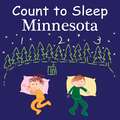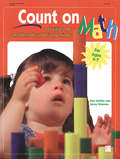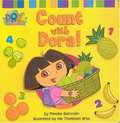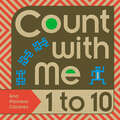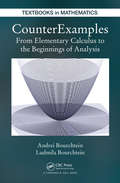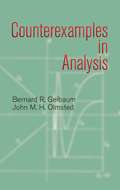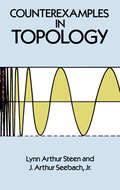- Table View
- List View
Count To Sleep Chicago (Count To Sleep)
by Adam Gamble Mark JasperMaking basic numbers fun to learn, this board book teaches kids to count to 10 using famous Chicago icons and landmarks depicted in whimsical illustrations. This concept book is a terrific way to introduce young children to a cherished destination while easing them to sleep at naptime or bedtime. Highlighting unique places and structures in Chicago, including Navy Pier, the Water Tower, the Field Museum of Natural History, and famous skyscrapers, this book is an exciting way to learn to count while celebrating many things that make the Windy City special.
Count To Sleep Florida (Count To Sleep)
by Adam Gamble Mark JasperMaking basic numbers fun to learn, this board book teaches kids to count to 10 using famous Florida icons and landmarks depicted in whimsical illustrations. This concept book is a terrific way to introduce young children to a cherished destination while easing them to sleep at naptime or bedtime. Exploring Florida, this counting book celebrates many of the Sunshine State’s most famous features, including the Atlantic Ocean and Gulf Coast, the Keys, the Everglades, Miami, Orlando, orange groves, beaches, boating, tropical fish, and much more.
Count To Sleep Maine (Count To Sleep)
by Adam Gamble Mark Jasper Joe VenoMaking basic numbers fun to learn, this board book teaches kids to count to 10 using famous Maine icons and landmarks depicted in whimsical illustrations. This concept book is a terrific way to introduce young children to cherished destinations while easing them to sleep at naptime or bedtime. Rocky coastlines, quaint seaside villages, lovely beaches, whitewater rafting, and Mount Katahdin—all things that make Maine special—are explored in this playful counting book.
Count To Sleep Massachusetts (Count To Sleep)
by Adam Gamble Mark JasperMaking basic numbers fun to learn, this board book teaches kids to count to 10 using famous Boston icons and landmarks depicted in whimsical illustrations. This concept book is a terrific way to introduce young children to cherished destinations while easing them to sleep at naptime or bedtime. Covering unique aspects of Boston, including Charles River boaters, Boston Harbor, the USS Constitution, the skyline, and marathon runners, this colorful board book explores the places and things that make Beantown special.
Count To Sleep Michigan (Count To Sleep)
by Adam Gamble Mark JasperYoung Michigan readers and visitors delight in counting some of this state’s most-loved attractions, including lighthouses, zoo animals, bridges, Mackinac Island ferryboats, cherry pickers, antique cars at The Henry Ford, and more.
Count To Sleep Minnesota (Count To Sleep)
by Adam Gamble Mark JasperMaking basic numbers fun to learn, this board book teaches kids to count to 10 using famous Twin Cities' icons and landmarks depicted in whimsical illustrations. This concept book is a terrific way to introduce young children to cherished destinations while easing them to sleep at naptime or bedtime. Exploring the Twin Cities from 1 to 10, this counting book celebrates icons of the area, including the skylines, bridges, winter scenes, Lake of the Isles, the State Capitol, and the beloved Spoonbridge and Cherry sculpture.
Count To Sleep New Jersey (Count To Sleep)
by Adam Gamble Mark JasperMaking basic numbers fun to learn, this board book teaches kids to count to 10 using famous New Jersey icons and landmarks depicted in whimsical illustrations. This concept book is a terrific way to introduce young children to cherished destinations while easing them to sleep at naptime or bedtime. Covering unique aspects of New Jersey, this book features the Jersey Shore, the boardwalk, pine barrens, and native wildlife, among other places and things that make the Garden State so special.
Count To Sleep New York City (Count To Sleep)
by Adam Gamble Mark JasperMaking basic numbers fun to learn, this board book teaches kids to count to 10 using famous New York City icons and landmarks depicted in whimsical illustrations. This concept book is a terrific way to introduce young children to cherished destinations while easing them to sleep at naptime or bedtime. Introducing kids to the wonders of New York City, this book features the Statue of Liberty, hot dog stands, taxi cabs, Central Park, and Broadway theaters, among other Manhattan icons.
Count To Sleep San Francisco (Count To Sleep)
by Adam Gamble Mark JasperMaking basic numbers fun to learn, this board book teaches kids to count to 10 using famous San Francisco icons and landmarks depicted in whimsical illustrations. This concept book is a terrific way to introduce young children to cherished destinations in San Francisco while easing them to sleep at naptime or bedtime. All the best that San Francisco has to offer—the city’s iconic cable cars, the Golden Gate Bridge, San Francisco Bay, Coit Tower, Golden Gate Park, and the nearby Redwood trees—is included in this playful counting book.
Count To Sleep Seattle (Count To Sleep)
by Adam Gamble Mark JasperCount to sleep Seattle features the Space Needle, Pikes Place Market, ferryboats, Mount Rainer, Museum of Flight, Woodland Park Zoo, Settle Aquarium, orcas, and houseboats. Count your way through the the great city of Seattle with this adorable counting book Young readers will count all their favorite city icons and landmarks, while being lulled into a peaceful nights sleep.
Count To Sleep St. Louis (Count To Sleep)
by Adam Gamble Mark JasperMaking basic numbers fun to learn, this board book teaches kids to count to 10 using famous icons and landmarks from St. Louis depicted in whimsical illustrations. This concept book is a terrific way to introduce young children to cherished destinations in St. Louis while easing them to sleep at naptime or bedtime. Young Missourians and visitors delight in counting with the Gateway Arch, St. Louis Art Museum, Missouri History Museum, St. Louis Zoo, symphony orchestra, local sports teams, and the Mississippi River.
Count To Sleep Texas (Count To Sleep)
by Adam Gamble Mark JasperGet ready to count the great state of Texas! Featuring whimsical illustrations that make basic numbers fun to learn, this concept book is a terrific way to introduce young children to cherished destinations in Texas while easing them to sleep at naptime or bedtime. Young Texans and visitors delight in counting bull riders, Texas Rangers bats, San Antonio riverboats, barbeque ribs, bluebonnets, Austin Bat Bridge bats, Lone Star flags, and more.
Count To Sleep Wisconsin (Count To Sleep)
by Adam Gamble Mark JasperMaking basic numbers fun to learn, this board book series teaches kids to count to 10 using famous icons and landmarks from cities and states across North America. Featuring whimsical illustrations, these concept books are a terrific way to introduce young children to cherished elements of Wisconsin while easing them to sleep at naptime or bedtime. From Wisconsin cheese to Cheeseheads, young readers will delight in the charms of the Badger State. Highlights include cranberries, cherries, dairy cows, Milwaukee Brewers bats, zoo animals, the Wisconsin Fair, and more.
Count To Sleep Yosemite (Count To Sleep)
by Adam Gamble Mark JasperMaking basic numbers fun to learn, this board book series teaches kids to count to 10 using famous Yosemite icons and landmarks. Featuring whimsical illustrations, this concept book is a terrific way to introduce young children to cherished elements of Yosemite while easing them to sleep at naptime or bedtime. All the best that Yosemite National Park has to offer is included in this playful, educational counting book.
Count and See
by Tana HobanThere are things to count all around you. If you look. And think. And see. Tana Hoban does -- and so will the youngest reader who accompanies her through this book. Exciting photographs -- reinforce by the number as word, as numeral, and as model set -- show you how to count what you see, and make what you see count.
Count on Math: Activities for Small Hands and Lively Minds
by Pam Schiller Lynn Peterson BrownThe activities in this book reflect children's real world math experiences--counting candles on a birthday cake, sorting and classifying toys, making sure there is a one-to-one correspondence between children and cookies. Children learn spatial relationships, patterning, shapes, numeration, and many other math concepts from these simple activities, such as "Nature Sort," "Human Rectangles" and "Stackable Snackables." Each chapted of this invaluable resource presents a new math concept in developmental sequence, and the activities in each chapter build on what the children have already learned. Unique features in every chapter include an introductory story, intriguing activities, evaluation criteria, and a newsletter to send home to parents. Each math concept is introduced with a story and ends with suggestions for home connections.
Count on Me
by Miguel TancoA young girl sees the world differently in this beautiful picture book celebration of math.Everyone has a passion. For some, it's music. For others, it's art. For our heroine, it's math. When she looks around the world, she sees math in all the beautiful things: the concentric circles a stone makes in a lake, the curve of a slide, the geometric shapes in the playground. Others don't understand her passion, but she doesn't mind. There are infinite ways to see the world. And through math is one of them.This book is a gorgeous ode to something vital but rarely celebrated. In the eyes of this little girl, math takes its place alongside painting, drawing and song as a way to ponder the beauty of the world.
Count to Sleep Washington, DC (Count To Sleep)
by Adam Gamble Mark JasperMaking basic numbers fun to learn, this board book teaches kids to count to 10 using famous DC icons and landmarks depicted in whimsical illustrations. This concept book is a terrific way to introduce young children to cherished destinations in Washington, DC, while easing them to sleep at naptime or bedtime. With a tour of the nation’s capital—the National Mall, the Potomac River, the Smithsonian museums, the White House, the Supreme Court, the Capitol Building, and many of Washington, DC’s monuments—this counting book celebrates the district’s numerous exciting and unique destinations.
Count with Dora! (Dora the Explorer)
by Phoebe BeinsteinYoung fans will love helping Dora count coconuts, bananas, and pineapples in English and Spanish.
Count with Me -- 1 to 10
by Ana Palmero CaceresCount from one to ten with a vivid set of unique animals!Inspired by the basket weaving of the Ye'kuana people of Venezuela, Ana Palmero Cácares's designs will delight young children as they learn their first numbers. A variety of animals such as jaguar, snake, armadillo, monkey, scorpion, and bat are featured. Appended with back matter about the traditional baskets that inspired the drawings.
CounterExamples: From Elementary Calculus to the Beginnings of Analysis (Textbooks in Mathematics)
by Andrei Bourchtein Ludmila BourchteinThis book provides a one-semester undergraduate introduction to counterexamples in calculus and analysis. It helps engineering, natural sciences, and mathematics students tackle commonly made erroneous conjectures. The book encourages students to think critically and analytically, and helps to reveal common errors in many examples.In this book, the
Counterexamples in Analysis (Dover Books on Mathematics)
by John M. Olmsted Bernard R. GelbaumThese counterexamples, arranged according to difficulty or sophistication, deal mostly with the part of analysis known as "real variables," starting at the level of calculus. The first half of the book concerns functions of a real variable; topics include the real number system, functions and limits, differentiation, Riemann integration, sequences, infinite series, uniform convergence, and sets and measure on the real axis. The second half, encompassing higher dimensions, examines functions of two variables, plane sets, area, metric and topological spaces, and function spaces. This volume contains much that will prove suitable for students who have not yet completed a first course in calculus, and ample material of interest to more advanced students of analysis as well as graduate students. 12 figures. Bibliography. Index. Errata.
Counterexamples in Probability And Statistics
by A.F. SiegelThis volume contains six early mathematical works, four papers on fiducial inference, five on transformations, and twenty-seven on a miscellany of topics in mathematical statistics. Several previously unpublished works are included.
Counterexamples in Probability: Third Edition (Dover Books on Mathematics)
by Jordan M. StoyanovMost mathematical examples illustrate the truth of a statement; conversely, counterexamples demonstrate a statement's falsity if changing the conditions. Mathematicians have always prized counterexamples as intrinsically enjoyable objects of study as well as valuable tools for teaching, learning, and research. This third edition of the definitive book on counterexamples in probability and stochastic processes presents the author's revisions and corrections in addition to a substantial new appendix. Suitable as a supplementary source for advanced undergraduates and graduate courses in the field of probability and stochastic processes, this volume features a wide variety of topics that are challenging in both content and detail. The text consists of four chapters and twenty-five sections. Each section begins with short introductory notes of basic definitions and main results. Counterexamples related to the main results follow, along with motivation for questions and counterstatements that range in difficulty. A familiarity with basic notions and results in probability and stochastic processes is assumed, and a chapter of supplementary remarks provides a wealth of information about original sources as well as references for further studies.
Counterexamples in Topology (Dover Books on Mathematics)
by Lynn Arthur Steen J. Arthur Seebach Jr.According to the authors of this highly useful compendium, focusing on examples is an extremely effective method of involving undergraduate mathematics students in actual research. It is only as a result of pursuing the details of each example that students experience a significant increment in topological understanding. With that in mind, Professors Steen and Seebach have assembled 143 examples in this book, providing innumerable concrete illustrations of definitions, theorems, and general methods of proof. Far from presenting all relevant examples, however, the book instead provides a fruitful context in which to ask new questions and seek new answers.Ranging from the familiar to the obscure, the examples are preceded by a succinct exposition of general topology and basic terminology and theory. Each example is treated as a whole, with a highly geometric exposition that helps readers comprehend the material. Over 25 Venn diagrams and reference charts summarize the properties of the examples and allow students to scan quickly for examples with prescribed properties. In addition, discussions of general methods of constructing and changing examples acquaint readers with the art of constructing counterexamples. The authors have included an extensive collection of problems and exercises, all correlated with various examples, and a bibliography of 140 sources, tracing each uncommon example to its origin.This revised and expanded second edition will be especially useful as a course supplement and reference work for students of general topology. Moreover, it gives the instructor the flexibility to design his own course while providing students with a wealth of historically and mathematically significant examples. 1978 edition.





